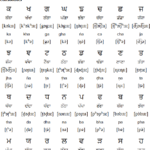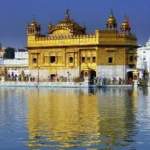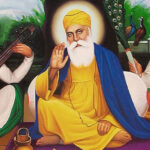Punjabi (/pndbi/;[12] (Shahmukhi); (Gurmukhi), Punjabi: [pdab] .bi] is an Indo-Aryan language spoken in the Punjab region of Pakistan and India. It is often written, in Panjabi. There are 113 million native speakers of it.
According to the 2017 census, 80.5 million people in Pakistan speak Punjabi as their first language, and according to the 2011 census, 31.1 million people in India speak Punjabi as their first language. A sizable abroad diaspora, mainly in Saudi Arabia, the United Arab Emirates, Canada, the United Kingdom, and the United States, speak the language.
Punjabi is written using the Shahmukhi alphabet in Pakistan, which is based on the Perso-Arabic script, and the Gurmukhi alphabet in India, which is based on the Indic script. The way that Punjabi uses lexical tone sets it apart from other Indo-Aryan languages and the larger Indo-European language family.
History\Etymology
The Persian name Panj-b, which means “Five Waters” and refers to the five principal eastern tributaries of the Indus River, is the source of the word Punjabi (also written Panjabi). The Turko-Persian invaders of South Asia gave the area its name, which is a translation of the Sanskrit name for it, Panchanada, which means “Land of the Five Rivers.”Panj is related to the Sanskrit word pacca, the Greek word penta, and the Lithuanian word penki, all of which imply “five.” B is related to the Sanskrit word áp and the Av- of Avon. The Indus River and these five tributaries together define physiographically the historical Punjab area, which is presently split between India and Pakistan. Paishachi Prakrit later gave birth to Paishachi Aparbhsha, a Prakrit descendent, in northern India. In the seventh century AD, Punjabi evolved as an Apabhramsha, a degraded variety of Prakrit, and by the tenth century, it had stabilized. The Nath Yogi period, which lasted from the 9th to the 14th century, produced the oldest Punjabi texts. Although the vocabulary and rhythm of these pieces are heavily infused with severe colloquialism and folklore, the language is morphologically closer to Shauraseni Apbhramsa.
Persian and Arabic influences
Persian is spoken throughout the Indian subcontinent, as well.
With the late first-millennium Muslim invasions of the Indian subcontinent, Arabic and contemporary Persian influence initially emerged in the ancient Punjab region.
Punjabi contains many words from Persian and Arabic. As a result, Persian and Arabic terms are frequently utilized in Punjabi with a flexible use of language. Many significant words, such as, etc., are derived from Persian and Arabic. Urdu was declared the official language of Punjab after the fall of the Sikh state (it is now the predominant official language of Pakistani Punjab), and it also had an impact on the language.
In actuality, Persian is where the sounds, and came from. Later, it was lexically impacted by Portuguese (words like /), Greek (words like /), Chagatai (words like/), Japanese (words like /), Chinese (words like, / ), and English (words like / ), however, these impacts were small in contrast to Persian and Arabic.
Modern era
There are numerous dialects of Punjabi spoken. For use in education and the media, the Majhi dialect of Punjabi has been accepted in Pakistan and India. The Punjabi Majha region is where the Majhi dialect first appeared.
In offices, schools, and the media in India, Punjabi is written using the Gurmukh script. Although English, one of India’s two main official languages at the Union level, has influenced Gurmukhi, which is the language’s official standard alphabet, Punjabi is frequently unofficially written in Latin scripts.
Although several attempts have been made to construct specific, distinctive letters from a derivation of the Persian Nastalq symbols to represent Punjabi phonology, Punjabi is typically written in Pakistan using the Shahmukh script, which in literary standards is identical to the Urdu alphabet not present in the Urdu alphabet previously. Like Urdu, Punjabi in Pakistan borrows technical terms from the Persian and Arabic languages.
Geographical spread
Punjabi is the most common language in Pakistan, the twelfth most common in India, and there is also a Punjabi diaspora in many other nations.
Pakistan
As the mother tongue of 80.5 million people, or around 39% of the population, Punjabi is the most extensively used language in Pakistan.
India
In addition to Delhi and Haryana, Punjabi is recognized as a second official language in India’s state of Punjab. Amritsar, Ludhiana, Chandigarh, Chandigarh, Jalandhar, Ambala, Patiala, Bathinda, Hoshiarpur, Firozpur, and Delhi are a few of its major urban centers in northern India.
Diaspora of Punjabis
In several other nations where Punjabi people have immigrated in substantial numbers, including the United States, Australia, the United Kingdom, and Canada, Punjabi is also spoken as a minority language. In 2021, there were 0.67 million native speakers of Punjabi in Canada, 0.3 million in the UK, 0.28 million in the US, and fewer in other nations.








